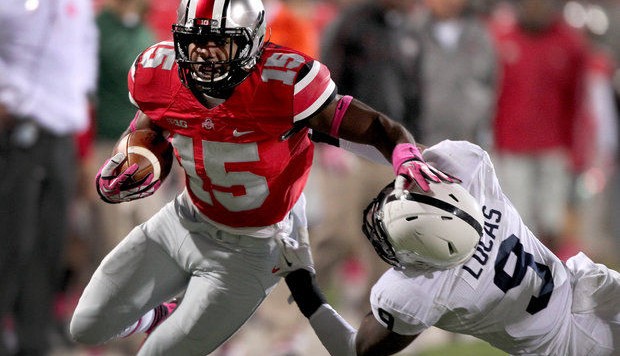Sept. 6, 2014.
The best thing that could have happened to this Ohio State team did. It lost to Virginia Tech and the season was altered completely.
The work that started on Sept. 7, 2014, is what has the Buckeyes where they are Monday – on the verge of a national championship against Oregon.
While much of the attention goes to the quarterback position and Urban Meyer, and rightfully so, there are a couple more emergences — and emergencies (both words work) — that allowed Ohio State to be where it is today.
Against the Hokies, the Buckeyes’ offensive line allowed seven sacks and permitted pressure on J.T. Barrett all night long. They Buckeyes’ linemen allowed only 20 sacks in the team’s subsequent 13 games. Addressing the offensive line was a huge reason why the Buckeyes’ season turned around. It allowed stability in the passing game, giving young quarterbacks time to not only throw, but feel comfortable as the season progressed. It also allowed Ohio State to establish the running game, which aids in pass protection as well.
After the Virginia Tech game, tight end Jeff Heuerman offered a quote to Yahoo! that struck me and predicted some of the future. Heuerman said, “This is not the last game of the season.” He then went on to discuss how Meyer delivered a message that “there is a lot to accomplish” for this team, but to do that, it had to go 11-1.
Also after the game, Meyer said he expected the “skill position players” to play better. There is no doubt they took that on, but nobody did so bigger or better than Ezekiel Elliott. He has been huge down the stretch for Ohio State, but did anyone know that his momentum began to develop following the loss? In his first two games, against Navy and Virginia Tech, Elliott got 20 carries for 76 yards combined. That is good for an NFL Trent Richardson-ish 3.8-yard average. The following week, Elliott only got nine carries, due to the blowout of Kent State, but his average was over nine yards per carry.
After the first two games of the season, Elliott only had one game in which he finished with under five yards per carry. That was the Oct. 25 game against Penn State, when he accumulated 109 yards and a score in a double-overtime victory. That was the toughest game Ohio State played between Virginia Tech and the playoff game against Alabama.
Not only was Elliott a source of fuel for the Buckeyes’ offense; there is no doubt that he came up huge when the squad needed him the most. In the last two games, the Big Ten Championship Game and the playoff semifinal, Elliott picked up 450 yards on 40 carries. Not only that, those performances came against two of the stronger run defenses in the country in Wisconsin (23rd in the nation) and Alabama (fourth).
Viewing Elliott’s season as a whole, he rushed for 1,632 yards and 14 touchdowns in 14 games. There were only six games in which Elliott failed to get over 100 yards. Three of them were the opening three games of the campaign. In two of the remaining games, he received a combined total of only 21 carries, due to blowouts of Rutgers and Illinois. The other was the Minnesota game, in which he picked up 91 yards.
While much of the attention will be given to the quarterbacks this weekend, if Ohio State defeats Oregon on Monday and takes home the national championship, it will be done with the overshadowed area of improvement that turned around the season: a progression not at quarterback, but on the offensive line, enabling Ezekiel Elliott to transform this team’s running game.

